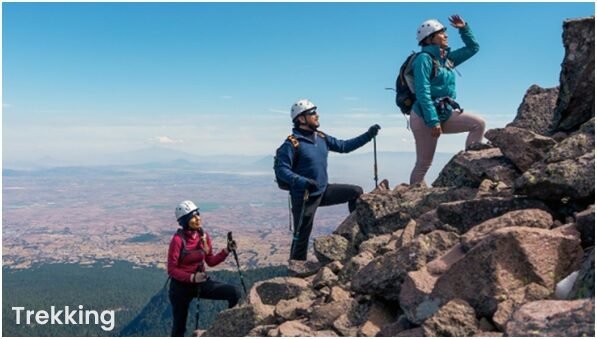Categories Trekking February 17, 2023
My Trekking Adventure Gear Checklist
Learn how to pack for a successful overnight Backpacking or Trekking Adventure Gear with lightweight gear essentials like a tent, stove, and clothing. My backpacking checklist!
From Backpacking in Dharamshala, Trekking in Stok Kangri, or Hill-walking in Har Ki Dun, I’m always searching for the lightest and most comfortable Trekking Adventure Gear. Updating my gear guides on a regular basis.
Fortunately, you get to benefit from my expensive hobby of collecting and testing Trekking Adventure Gear by learning from my experiences using it during adventures around the world.
Backpacking VS Trekking
Although We are majorly talking about The Trekking Adventure Gear in this blog but still, first off, I want to define the difference between Backpacking, Trekking, and Hiking. These words are sometimes used interchangeably — but they can also have different meanings depending on who you ask.
Backpacking is a Hiking trip that includes Overnight Camping. Packing everything you need to be self-sufficient in the wilderness on your back. Like my 10-day solo backpacking trip in Dharamshala.
Trekking is hiking long-distance, for days or weeks at a time. You might pack everything in yourself, but more likely you’ll have a guide and pack animal or human porter to help you. You may or may not need to bring your own shelter. Like my trek in the mountains of Stok Kangri with a local guide & pack horse.
Hiking is just walking on a wilderness trail through the mountains, forest, desert, or even the countryside. Generally, this is used to define day hikes that don’t require an overnight stay. Like my day hike up at Har Ki Dun(Uttrakhand).
I’m going to focus on a typical 2-5 day backpacking trip, packing in your own food, water, and gear. But much of this will also work as a trekking packing list.
Lightweight Backpacking Checklist
Backpacking Checklists & Packing Lists can be controversial subjects. Everyone has an opinion about what’s the Best Trekking Adventure Gear to bring on a trip!
You have your traditional backpackers, lightweight backpackers, and even ultra-light thru-hikers who all do things differently.
Choosing A Trekking Backpack
Rucksack Bag / Rucksack Meaning
A bag with shoulder straps which allow it to be carried on someone’s back, typically made of strong, waterproof material and widely used by hikers. For multi-day Trekking Backpacks, where you’ll need to carry everything on your back, I recommend choosing a 40-65 litre backpack that will hold your tent, sleeping bag, food, water, and other Backpacking Essentials.
-
- Greenlands Tritus 40 Litres Rucksack – This is the backpack I take with me on most 2-3 day trips. It’s super lightweight, comfortable, and well-designed. Its best feature is its access to the main compartment with a front zipper opening where I don’t need to take the bag off my shoulders and unbuckle the top flap which still gives access to just the topmost stored contents, or otherwise rummage right through till the bottom. I just open the zip and everything from top to bottom is accessible.
-
- Greenlands Axido 50 Litres Rucksack – For long-distance treks with the potential for more extreme weather, or more weight (like winter camping), I prefer this since this has more space and is more weather resistant because of the rain cover it comes with. Its other great feature is the padded adjustable hip belt that helps me transfer the weight off from the shoulders to the waist for walking over long periods.
Color-coded Stuff Sacks
To keep your backpack organized during your Trekking adventure, I recommend using a few lightweight stuff sacks and/or packing cubes, in different colors, so it’s easy to grab important gear quickly.
Tents & Overnight Shelters
If you plan to sleep outside in the wilderness, you’re going to need a quality shelter to pack with you. Traditionally this would mean using a tent, but a hammock or bivy bag are other possible options. While I own and use all three types of shelters, generally I think most people should start with a tent.
Lightweight Tents
This is one of your most important pieces of Trekking backpack gear. You want to find a tent that is a good combination of lightweight, spacious, waterproof, and easy to set up. It’s basically where you’ll be living during your trip!
Trekking Hammocks
If you’re going to be Trekking in a forest or jungle, it might make sense to hang a hammock for your backpacking shelter. A hammock keeps you off the ground, away from bugs & wet conditions, but is also easy to pack with no aluminum poles. Some people prefer sleeping in them to tents also.
Warm Sleeping Bag
For a good night’s sleep, you need a warm sleeping bag. The key is to pick a bag rated warm enough for the weather you’ll encounter on your backpacking trip.
Down sleeping, bags are warmer with less weight, but also more expensive. Synthetic bags weigh a bit more but are more affordable. For extremely cold weather conditions (under 0 degrees F), layering two sleeping bags is ideal.
Comfortable Sleeping Pad
Sleeping pads have come a long way over the years. From bulky rolled pieces of foam to lightweight inflatable versions with high-tech baffles that take up far less room in your pack. A good sleeping pad can make a huge difference in how much you enjoy trekking outside.
Backpacker Kitchen
You don’t need to lug a ton of pots & pans into the wilderness anymore. A lightweight backpacker kitchen allows you to boil water for cooking simple dehydrated meals on the go which includes Camp Stove, Fuel & a Mug/Bowl/Spoon set.
Trekking Clothing
Base Layers
Lightweight, breathable, synthetic t-shirt. I wear one and pack a spare. They weigh nothing. I always bring one pair of thermals to sleep in or wear under my clothes in cold weather.
Mid-Layers
I always bring one pair of thermals to sleep in or wear under my clothes in cold weather.
Down/Synthetic Puffy
Lightweight, packable down jacket with a hood. For extra cold conditions, or under a waterproof shell jacket.
Socks & Underwear
I generally pack 3 pairs of socks on my Trekking Adventures. Two pairs to alternate for hiking (so my feet are always dry) and some thick wool socks for sleeping. One spare set of underwear.
Trekking Adventure Outerwear
These are the outer layers that protect you from nature’s wrath — the wind, rain, and snow. You should always pack some sort of rain gear on any backpacking adventure.
Warm Gloves & Hat
Obviously, this is going to depend on the season, but I usually bring something to keep my head and hands warm just in case the weather turns bad, or it’s colder than expected at night.
Trekking Shoes Or Boots
There is an ongoing discussion in the backpacking world about the benefits of using Trekking shoes over heavy Trekking boots. I own a pair of each and use them for different situations.
Trekking Food
Here’s the deal. I’m not a backpacker gourmet cook like some people are. Food is just fuel to me. So I keep my diet simple and fast to prepare
Trail Mix & Snacks
Usually bags of trail mix (nuts, dried fruit, etc) and some energy bars.
Dinner: Dehydrated Food
Tasty dehydrated bags of food that just need some hot water to prepare. You can eat right out of the bag too!
Breakfast: Instant Oatmeal
Instant oatmeal packets with some extra protein in different flavors. I usually add some dried berries too.
Coffee!
I’ll be the first to tell you I’m not a big Starbucks fan in person. But their instant coffee packets are pretty damn good.
Trekking Personal Hygiene Items
Wilderness Wash
Biodegradable soap that’s safe for the environment.
Quick-Dry Towel
To dry off after a cold-water dip in lakes or rivers!
Bamboo Toothbrush
Cut it in half for a travel-sized (and environmentally friendly) version.
Shaving Kit!
Ok, this isn’t a backpacking essential. But a simple shaving kit is part of my own personal hygiene routine. So I thought I’d include it for entertainment value! I pack a razor, a small tube of environmentally friendly shaving cream, and a camp mirror.
The 10 Trekking Adventure Gear Essentials
These are the 10 most essential items to take with you on any Trekking adventure. From long-distance trekking to simple day hikes. They will help you survive in the wilderness during normal conditions or in an emergency situation.
1. Navigation
Getting lost in the wilderness can turn dangerous quickly. Knowing where you are, and where you need to go, is an essential part of safe backpacking.
2. Headlamp
Always pack a light to find your way back down the trail after an epic summit sunset! Or Overnight Trekking Trips. Plus a set of spare batteries.
3. Sun Protection
Many people underestimate the power of the sun, and a bad sunburn or sun blindness can quickly ruin a great trip. I always pack a combination of wilderness-friendly sunscreen, sunglasses, a hat, and a lightweight Buff.
4. First Aid Kit
Some kind of first aid kit is a must on any Trekking Adventure Gear list.
5. Water & Filtration System
Hydrate, hydrate, hydrate! Always research how much water you need to bring on a hike to stay properly hydrated, and bring a water purification system too.
6. Sharp Knife
A key piece of survival equipment for Trekking Adventures.
7. Fire Kit
To help you cook food, boil water, and stay warm in an emergency situation. You don’t need to go crazy. I usually bring a pair of Bic Lighters, some cotton balls in a tiny zip-lock bag for tinder, and a few water/wind-proof matches.
8. Emergency Shelter
If you’re on an overnight Trekking trip, you’ll already have a tent as I mentioned earlier. But I also recommend bringing an emergency shelter (tent blows away, burns down, etc). It’s also wise to pack a shelter on long day hikes, in case you get injured or lost and need to spend the night.
9. Extra Food
Always bring at least an extra half day’s worth of food with you on day hikes and a full extra day’s worth of food on longer multi-day Trekking Adventures for unexpected situations.
10. Extra Clothing
Pack a few warm layers (thermal underwear, extra socks, hat, gloves, etc.) to help you stay warm & dry if the weather turns bad, you fall into a river, or have to spend an unexpected night in the wilderness.
Ok, That is all for now…
If you enjoyed this article please, Share and Like our Facebook Page. Thanks.



